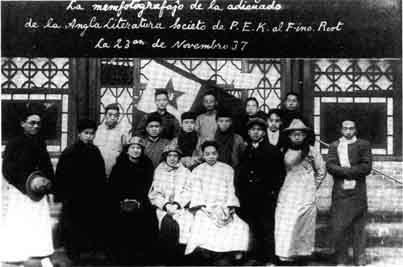
|
Traces That Remain:
A Pictorial History of the Early Days of the Bahá'í Faith among the Japanese
by Barbara R. Sims
edited by Sheridan Sims  |
chapter 28 | start page | single page | chapter 30 |  |
Chapter 29
This photograph was taken in Tokyo, May 1922, at a dinner given by a Japanese newspaper for nineteen Chinese women from Peking Women's
Teachers College. They were the first Chinese women to be sent to Japan to inspect the school system. When Miss Alexander read that they were to be honored that evening she went to the newspaper and asked if she might attend the dinner. Of course, she received an invitation. One of the women invited Miss Alexander to speak at her school if she should come to China. She did this a year and a half later.Shown here are the nineteen Chinese women, their Japanese hosts and Miss Alexander (far right in striped dress).
In the early 1920s a group of Chinese newspaper men and several groups of Chinese students visited Japan. Most of the students were training to become teachers. Miss Alexander sought out all groups of Chinese when she read that they had come to Tokyo, becoming friendly with them and telling them of the Message of Bahá'u'lláh. She subsequently corresponded with several of them after they returned to China. These connections had far-reaching results. One of the newsmen published in Chinese the Words of Bahá'u'lláh and 'Abdu'l-Bahá, in twenty-five editions of the widely circulated "Canton Times."

click here for larger image
1923. A school for army officers' children. Every child was given a Bahá'í pamphlet in Chinese to take home. Miss Root's hat can be seen near the top right.

click here for larger image
Before her trip to China Miss Root wrote to Miss Alexander asking if she could have a Bahá'í booklet called "9" translated into Chinese. Miss Alexander asked Mr. Waung to do it. When Miss Root and Miss Alexander visited China in 1923 they were invited to speak at many schools partly because of Miss Alexander's earlier connections with the teachers, and they now had the new pamphlet in Chinese to give out. This pamphlet was reprinted in several editions and thousands of copies were distributed throughout China.
 |
chapter 28 | start page | single page | chapter 30 |  |
|
|
